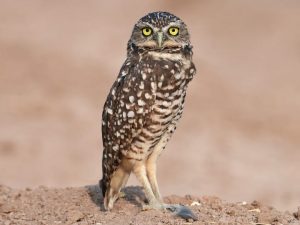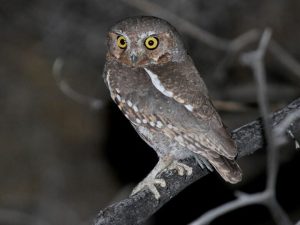Podcast: Play in new window | Download (Duration: 9:06 — 10.8MB)
This week we learn about two tiny owls! Thanks to Elizabeth and Alexandra for their suggestions!
Further reading:
The burrowing owl is tiny but fierce [photo by Christopher Lindsey, taken from page linked above]:

The elf owl is also tiny but fierce [photo by Matthew Grube, taken from page linked above]:

Show transcript:
Welcome to Strange Animals Podcast. I’m your host, Kate Shaw.
This week we’re going to learn about two tiny owls. Thanks to Elizabeth and Alexandra for their owl suggestions!
The burrowing owl is native to the Americas, especially the western part of North America, and most of Central and South America. It prefers grasslands and other open areas. It’s a small owl, not much bigger than the average songbird. It’s mostly brown with lighter underparts that are barred with a brown pattern.
You can tell a lot about an owl by the color of its eyes. In general, an owl with dark eyes is most active at night, an owl with orange or red eyes is likely to be most active at dawn and dusk, and an owl with yellow eyes is often active in the day. That’s not a hard and fast rule, but it can help you make a good guess about an owl’s behavior. The burrowing owl has yellow eyes, and it is indeed active in the day. The term for daytime activity is diurnal.
In past episodes I’ve said that owls have long legs that are usually hidden by feathers. In the case of the burrowing owl, its long legs are in plain sight because it spends a lot of the time running around on the ground. It will sometimes chase prey on foot, but other times it will perch on a fence post, tree branch, or some other high place to watch for a small animal to pass by. Then it will swoop down to grab it just like any other owl. It eats mice and other small rodents, lizards, small snakes, frogs, large insects and other invertebrates like scorpions and caterpillars, and birds. It especially likes termites and grasshoppers. Females are more likely to hunt during the daytime, while males are more likely to hunt at night or at dawn and dusk. Sometimes the burrowing owl will eat fruit and seeds too. When the burrowing owl has more food than it can eat, it will store some in underground larders.
The burrowing owl gets its name because it builds a nest in a burrow in the ground, often in burrows dug by other animals like prairie dogs and skunks. Some subspecies of burrowing owl will dig its own burrow, and all subspecies will enlarge an existing burrow until it’s happy with the size. It uses its beak to dig and kicks the dirt out with its feet. Both the male and female will work on the burrow together. Once it’s the right size and shape, the owl will bring in dried grass and other materials to line the burrow. One of its favorite materials is dried animal dung, especially from cattle. The dung releases moisture inside the burrow, making it more comfortable, and attracts insects that the owls eat. Win-win! It will also scatter animal dung around the entrance of its burrow and will sometimes also collect trash like bottle caps and pieces of foil to decorate the entrance.
The female lays her eggs in the burrow and spends most of her time incubating the eggs, only going outside briefly to stretch her legs. The male stands guard at the entrance to the burrow or nearby except when he’s out hunting. He brings food back for the female.
When the eggs hatch, both parents take care of the babies. At first the chicks stay in the burrow, but as they grow older they come out to play outside and start learning how to fly. Since burrowing owls usually nest in small colonies, there’s always an adult watching for danger somewhere nearby.
Most birds abandon their nests after their chicks are grown. The burrowing owl often uses its burrow year-round, although populations that migrate will usually make a new burrow when they return to their summer range. The burrow gives the owls a place to nap during the hottest part of the day, and it’s also a good place to hide if a predator approaches. Rattlesnakes also use burrows for the same purposes, and when a burrowing owl runs from a predator and hides in its burrow, it will mimic the rattling and hissing of an angry rattlesnake. A lot of times that’s enough to make a predator think twice about digging up the burrow.
This is what a burrowing owl sounds like when it’s not imitating an angry rattlesnake:
[burrowing owl call]
The burrowing owl is increasingly threatened by habitat loss and introduced predators likes cats and dogs. Luckily it’s an adaptive bird and is happy to use artificial burrows in protected areas. It’s a useful bird to have around since it eats a lot of insects, prairie dogs, and other animals that are considered pests by humans. Plus it’s an incredibly cute bird. I mean, it’s a tiny owl with long legs! How could you not find that cute?
Small as it is, the burrowing owl isn’t the smallest owl known. The elf owl is even smaller, about the size of a sparrow. It’s only about 5 inches tall, or 13 cm, with a wingspan of only 9 inches, or 22 cm. It lives in parts of the southwestern United States during the summer and parts of Mexico during the winter.
The elf owl is nocturnal like most other owls, and this is where our guideline of owl eye color breaks down, because the elf owl has yellow eyes. Its feathers are mostly gray or grayish-brown with white streaks. When it’s sitting on a twig, it kind of looks like a dead leaf or a broken-off branch.
It mostly eats insects, but it also likes scorpions, spiders, and centipedes. Occasionally it eats small reptiles or mammals. When it catches a scorpion, it removes the stinger before eating the scorpion, but it doesn’t seem to be hurt by actually being stung. It’s a fast, acrobatic flyer and catches insects on the wing, but it also hunts for insects on the ground and has long legs like the burrowing owl.
The elf owl nests in holes made by woodpeckers in trees or cacti, and the male brings the female food while she keeps the eggs warm. After the babies hatch, the male brings them food too and also continues to feed the female for another couple of weeks, until she starts to hunt again. The male will also catch a tiny snake called the western threadsnake, which looks a lot like an earthworm and only grows a foot long at most, or 30 cm, and is usually much smaller than that. It lives underground most of the time and while it has eyes, they don’t work except to sense light and dark. It eats insects, especially termites and ants. When an elf owl catches one of these little snakes, it doesn’t eat it. Instead, it brings the snake back to the nest and lets it go. The snake eats all the insects it can find, including parasites that might hurt the baby owls. Then again, sometimes the nest is inhabited by tree ants that do the same thing, cleaning up all the parasites and scraps of leftover food while not bothering the owls.
If a predator grabs an elf owl, or a scientist nets and handles one, the owl pretends to be dead. A lot of times this will cause the predator to relax its jaw muscles, which often allows the owl to wiggle free and fly away. The scientists are a little more careful about relaxing their hands, but when a scientist handles an elf owl, it’s usually to do a quick examination and maybe put a leg band on for identification purposes, and then they let the owl go again anyway.
This is what an elf owl sounds like:
[elf owl call]
You can find Strange Animals Podcast at strangeanimalspodcast.blubrry.net. That’s blueberry without any E’s. If you have questions, comments, or suggestions for future episodes, email us at strangeanimalspodcast@gmail.com. We also have a Patreon at patreon.com/strangeanimalspodcast if you’d like to support us for as little as one dollar a month and get monthly bonus episodes.
Thanks for listening!